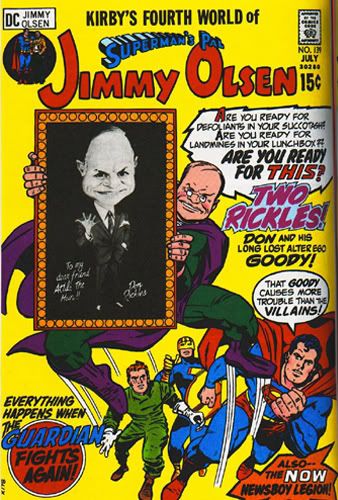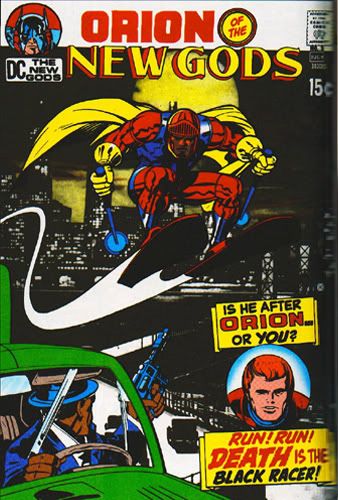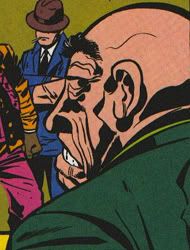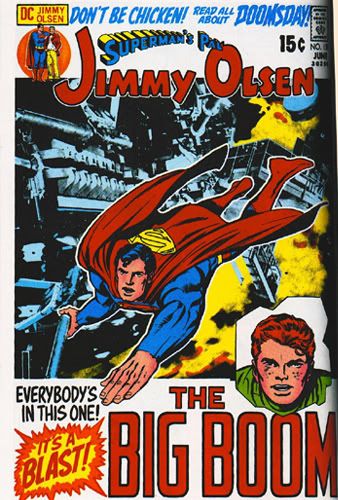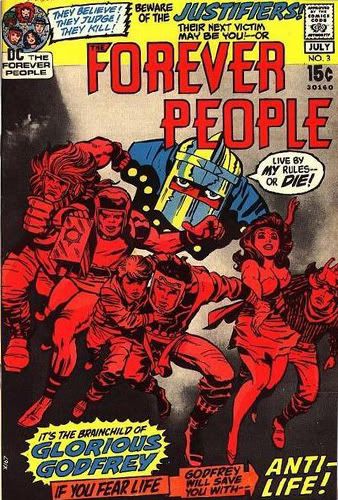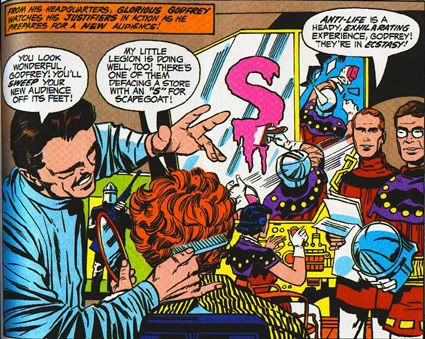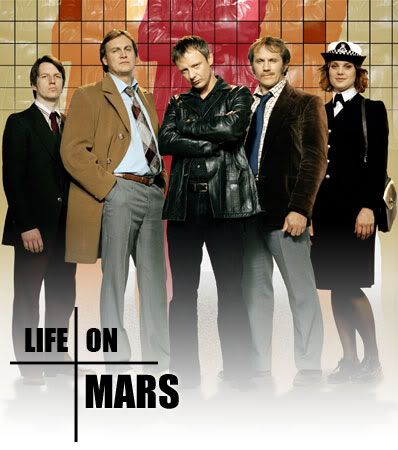
Wrapping up the final issue of the first omnibus on a high note, “The Paranoid Pill” sees Kirby getting more comfortable with Mister Miracle just as he was with The Forever People. The pacing here is better, the characters’ behaviour is more logical, and the idea of Mister M. undergoing a series of trials at the hands of his former classmates is better handled here than it will be even in the next volume.
Which is not to say it isn’t mockable by a shallow and juvenile yutz like myself! Here’s the awesome opening caption to this issue:
Sometimes, there are things that take place in empty rooms that defy belief, and so go unnoticed!!
No, seriously: sometimes things that happen in empty rooms go unnoticed. I know it’s hard to believe, but it’s true.
What’s happening in this particular empty room is that a Boom Tube from Apokalips is coming through, and a horde of faceless silver androids are pouring out. Kirby explains via caption that these are “‘Animates’ manipulated by the power of a single mind!” So you’d think they’d have no need to spout expository dialogue to each other, wouldn’t you? You’d think that, but you’d be wrong. Not to harp on it, but this really takes away from the eeriness of the scene. Again, it’s kind of surprising that an artist like Kirby took so long into the Fourth World to figure out the value of just shutting up and letting the pictures tell the story, but I guess he was still working his way out from under Stan Lee’s influence. That aside, though, it's really an incredibly awesome little scene, both as a weird set-piece and as a metaphor for the character we're about to meet: his entire existence is a series of redecorations of vacant suites.
Having furnished the room and placed a single, central “Animate” in a chair in the center of the room, we watch as the “mind-force” takes possession of this body and molds it into the distinctively bizarre form of…Doctor Bedlam.
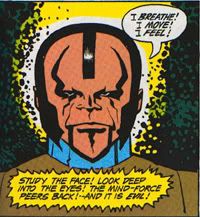
And all the while, the exposition is flying fast and furious, explaining that the Doctor is pure mind, able to inhabit bodies at will, that he serves Darkseid, and that he’s here to subjugate Scott Free.
I know it hardly needs to be said that Kirby characters talk a LOT when they don’t need to, and much of what they say doesn’t make a whole lot of sense anyway, but in this case, Bedlam is literally talking to himself—the only other people in the room are the Animates, who only have a semblance of life because he animates them. But what’s really hilarious is the kind of stuff he feels the need to explain to the audience. “Here on Earth, by the simple act of lifting this primitive instrument men call a telephone, I shall begin the little charade I have planned!” Then later: “Nothing can be hidden from one such as I, Scott Free! Your telephone number is known to me!!!” Doctor Bedlam has use of a demonic Apokaliptian device known as the “Telephone-book!”
Man, I want a whole comic just of Doctor Bedlam’s daily routine. “By activating the ‘tooth-brushing’ device, I can render my teeth, which I use to masticate food, to a spotless white, as though I had not eaten an entire bag of ‘potato-chips’ this evening! And soon, I shall evacuate my bowels into the toilet! It shall be as though the chips had never existed!”
Splash page time! We cut to Scott, shackled into a particularly elaborate set of restraints that sort of look like an upright set of medieval stocks. Hanging above him is a gigantic granite block, which Oberon opines will fall in mere seconds…but Scott is barking at Oberon to answer the phone.
Who else feels bad for Oberon? I mean, he’s been in show business a lot longer than Scott, yet Scott pretty much instantly assumed the mantle of overbearing master and started ordering him to do menial tasks for, as far as I can see, no money. I mean, as we’ve seen, performing in front of an audience is the last thing on Scott’s mind. He just whips up these spectacular devices from common household items, escapes from them once, and then leaves Oberon to clean up the mess. Or else he’s running off to challenge some weirdo and leaving Oberon to worry about him. Dude, seriously, even if it’s your goal in life to be an escapist’s assistant, you have better options. I hear David Blaine is hiring. I’m sure he’s only 9/10ths the asshole Scott is.
Anyway, despite the ringing phone (and you’d think that a distraction like that could really screw up a split-second escape, but no, Scott Free is just that good) Scott escapes. Oberon takes the call for him. “That’s odd!” mutters Scott. “I know no one in this area, Oberon!” Wow, that is odd. It couldn’t be that the caller is somehow…transmitting his voice an extended distance, using some kind of…tele-phonic…technology? No, that’s too crazy.
Scott takes the call and agrees to Doctor Bedlam’s terms of battle. By the way, Bedlam refers to his plan as “a charade”, and yet the villainous sorts who hail from Apokalips seem to adhere to a ridiculously formal and honourable code of conduct, as we’ll see clearly in this book. At least, they do when confronting Mister Miracle. Others have no qualms with sending genetically altered super-strong Jimmy Olsens to do their fighting for them.
There follows an extended four-page sequence in which Scott explains that Doctor Bedlam is a creature of pure mind, who would crush them were they not protected by Mother Box. They then proceed to hold a weird little séance in which they feel themselves assaulted by unknown terrors—Doctor Bedlam’s mental attack, which Scott provoked for some reason. Really, there’s nothing wrong with this sequence—actually, it’s kind of creepy—but it’s a little jarring to see Kirby spending so much time building up the situation. After all, in some of the earlier issues, major plot points were dispensed with via one-panel blocks of exposition. Here Kirby’s actually taking the time to set up the characters, and my knee-jerk response is, “Hurry up! Get to it already!” even though this comic is still way more compressed than your average Brian Michael Bendis story.
Mister Miracle confronts the Doctor in his ersatz office, which we now learn is on the top floor of an office building called “Chandler Towers.” Just be thankful it’s not “Joey Towers.”
When Mister Miracle refuses to submit to Bedlam’s citizen’s arrest, he displays the lynchpin of his plan: a tiny, nondescript pill. Mister Miracle protests that the code of combat disallows Bedlam from tranquilizing an adversary, but Bedlam replies that his is not what he has in mind. Instead, he’s going to drop the pill into the building’s ventilator system, whereupon it changes into vapour and infects the “literally thousands of Earth folk” in the building with raving, homicidal madness. (I’m not sure that even a huge office tower is likely to hold thousands of people, but never mind.) Mister Miracle’s mission, should he choose to accept it—and he already has—is simply to walk out the front door of the building…which will entail getting past thousands of extras from 28 Days Later without, presumably, doing them any serious harm.
“No metal, no gimmickry, no medieval chain or link for you, my boy! My world is of the mind!--And all the twists and turns that lead it to the pit! ”
I don’t know about you, but I find this to be seriously cool. Much better than that stupid “X-Pit” which you can get out of by pushing buttons, or even some of the heavy-duty traps he escapes from later. It’s a genuine “escape”, but one that requires him to use his wits and resourcefulness instead of just his manual dexterity (or whatever handy Apokaliptian technology he happens to have up his sleeve that month). And it’s certainly an escape that’s actually going to be substantial enough to fill an entire issue, for a change. Or even two.
Mister Miracle, overcome with rage, gives Bedlam a serious booting, but he’s already vacated the robot body in question. Meanwhile, the inhabitants of the tower have gone crazy…COMIC BOOK STYLE!
BIG-MOUTHED MAN: Someone here wants to kill me!
CRAZY LADY: It’s the UFO’s! They’ve landed!
BESPECTACLED GUY: I don’t have to work here! I’m needed in the president’s cabinet!
SECRETARY: You ruined my typing!
OTHER SECRETARY: You lie!
I especially like the delusions of grandeur mixed in there. Nice touch, Bedlam.
A guy who thinks he’s being held prisoner smashes down doors. A security guard starts blasting away at “robbers”. “From every doorway—in every corridor—madness, in all its horror, spins into wild frenzy…” No, worse than madness…DARKNESS! KRUG!
“Bedlam’s Paranoid Pill seems to be working!” muses Scott.
Being a logical sort, Scott’s first thought is to simply fly out the window on his aero-discs, but it seems that Doc Bedlam’s sealed the building with “COSMI-CURRENT!” Meanwhile, a gang of freaked-out citizens, including a railroad worker for some reason,
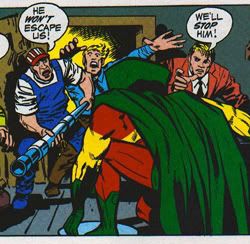
have beaten down the door and are after Scott with drainpipes and whatnot. Scott manages to fly past them with the aero-discs, dodging thrown items and worrying that “one of them is bound to get lucky and…” Well, uh, not that I’d particularly want a vase upside my head either, but aren’t you, like, a New God, Scott? I mean, in “The Forever People” and “New Gods/Orion” they make a pretty big deal about how only Apokaliptish weapons can hurt them. You’d hardly think he has much to be afraid of from a couple of thrown bits of debris.
Nevertheless, it’s probably prudent of him to avoid this stuff, which he does by slipping into an elevator…somehow failing to notice it’s occupied. By a dude with a gun, no less.
With bullets ricocheting around the elevator, Scott hits the emergency stop and gets out on the 45th floor—only to be met with another howling mob. They’re convinced he’s a demon, because “only a demon would look like that—and dress like that!” Well, a demon or a Mardi Gras dancer. Six of one, half a dozen of the other.
The mob subdues him, Scott, of course, being restrained by his unwillingness to hurt anyone. They manhandle him into a trunk and chain it shut, the whole way shrieking that he’s a demon, that he’s dangerous to them, that they have to destroy him…and then someone insists that they can’t let him suffocate in there. So they punch air holes.
Um…why even bother? One way or another, it’s not like Scott is about to spend a lot of time in the trunk. And needless to say, this sudden care for his well-being is pretty nonsensical, coming from a ravenous mob. Kirby really should have just had them try to frantically stab him through the trunk, with the air holes being a minor benefit.
Anyway, proclaiming themselves to be heroes for ridding the world of this demon, the howling residents of Chandler Towers manhandle the trunk to the central stairwell of the building and drop him down, 45 flights of stairs, to the bottom. “I waited too long!” Thinks Scott. “The chances of my escaping from this-- are ten past zero!!!”
Oh, OK, then. End of the book, I guess. No need to—oh wait, it’s to be continued. But I’m sure he can’t escape, right? I mean, who wastes time thinking, “Gee, I can’t escape from this,” and then immediately escapes?
Mister Miracle, that’s who!
